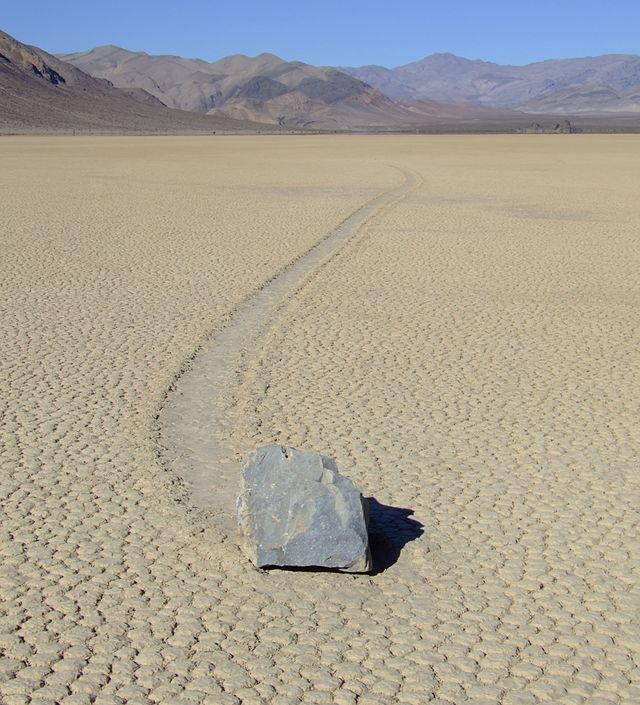

Sailing stones, sliding rocks, and moving rocks all refer to a geological phenomenon where rocks move and inscribe long tracks along a smooth valley floor without human or animal intervention. The stones move only every two or three years and most tracks develop over three or four years. Stones with rough bottoms leave straight striated tracks while those with smooth bottoms tend to wander. Stones sometimes turn over, exposing another edge to the ground and leaving a different track in the stone's wake.
Trails differ in both direction and length. Rocks that start next to each other may travel parallel for a time, before one abruptly changes direction to the left, right, or even back to the direction from which it came. Trail length also varies Ð two similarly sized and shaped rocks may travel uniformly, then one could move ahead or stop in its track.
Tracks of sliding rocks have been observed and studied in various locations, including Little Bonnie Claire Playa in Nevada, and most notably Racetrack Playa, Death Valley National Park, California, where the number and length of tracks are notable. At Racetrack Playa, these tracks have been studied since the early 1900s, yet the origins of stone movement were not confirmed and remained the subject of research for which several hypotheses existed. However, as of August 2014, timelapse video footage of rocks moving has been published, showing the rocks moving at low wind speeds within the flow of thin, melting sheets of ice. The scientists have thus identified the cause of the moving stones to be ice shove.
United States: 'Sailing rocks' mystery finally solved BBC - August 29, 2014
Scientists have finally solved the mystery of how rocks can move across the flat ground of a dry lake bed in Death Valley, California. Visitors have long been puzzled by the sight of boulder tracks criss-crossing a dusty bowl known as the Racetrack Playa in Death Valley National Park. But two researchers now say the rocks - which can sometimes be heavy and large - are propelled along by thin, clear sheets of ice on breezy, sunny days. They call it "ice shove". "I'm amazed by the irony of it all," paleobiologist James Norris tells the LA Times. "In a place where rainfall averages two inches a year, rocks are being shoved around by mechanisms typically seen in arctic climes."

A Sailing Stone in Death Valley
NASA - February 22, 2012
